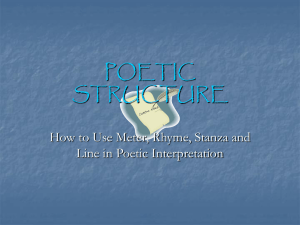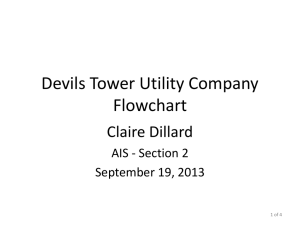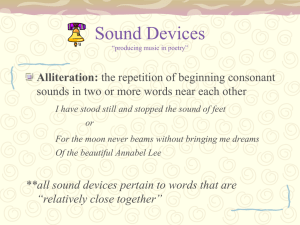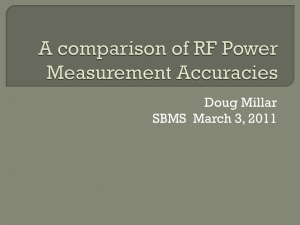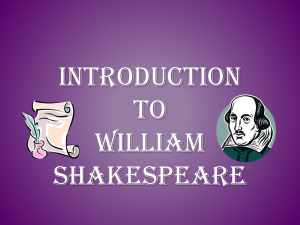EDCI Meter - svenssonpoetryunit
advertisement
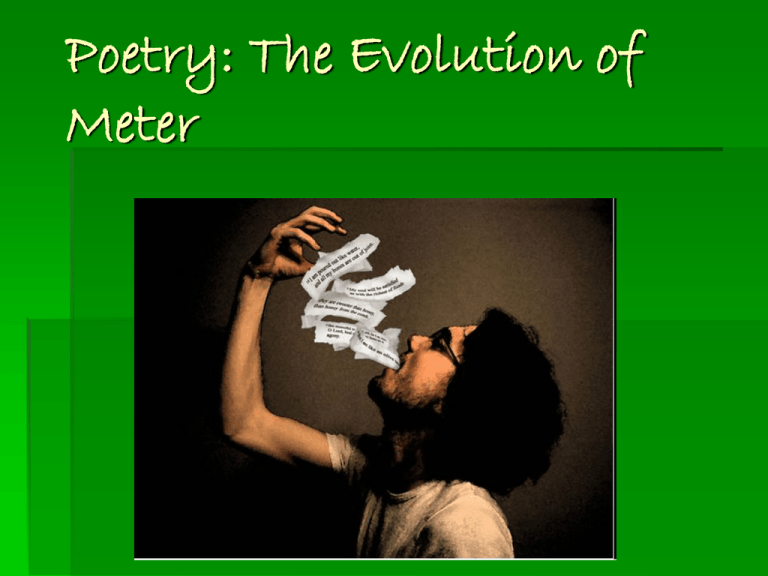
Poetry: The Evolution of Meter Greek Roots The western tradition of poetry rests upon a Greek foundation Greek poets introduced the idea of meter, which measure the stresses and syllables of a poem. Consider the line: “Rough winds do shake the darling buds of May” As you say the line aloud, count how many syllables there are. How many did you count? Shakespeare’s Meter “Rough winds do shake the darling buds of May”—how many iambs do you count? This line, from Shakespeare’s Sonnet 18 contains 5 iambs. Since there are 5 feet, the meter is referred to as Iambic Pentameter. Shakespeare most often used this type of meter in his plays and sonnets. Other kinds of meter are used as well by formal poets: 1 foot: monometer 2 feet: dimeter 3 feet: trimeter 4 feet: tetrameter 5 feet: pentameter 6 feet: hexameter 7 feet: heptameter 8 feet: octameter Meter Did you count 10? Now say the line again, this time focusing on how your voice rises and falls with the natural rhythm of the line: “Rough winds do shake the darling buds of May” “Rough winds do shake the darling buds of May” Did you notice a natural stress on the words: Winds, shake, darling, buds, & May? The most basic unit of meter is a foot. The most common is the iamb, which is an unstressed syllable followed by a stressed syllable. The line above is made up of iambs. Say the line again and notice the alternating pattern of iambs. Scansion: how to scan a poem for meter Scansion refers to using your pen and pencil and marking up a poem to find its meter. Use the symbols to mark up the following line: “We wear the mask that grins and lies” Notice that the line is iambic tetrameter because there are 4 iambs. Types of feet! Trochee (trochaic): TUM te ex: Rotten Spondee (spondaic): TUM TUM ex: grape fruit Pyrrhic: te te ex: at the front door Anapest (anapestic): te te TUM Dactyl (dactylic): TUM te te ex: intervene ex: loveliest *Use the scansion symbols to mark the stresses on each example Meter through History Syllable-stress meter was dominant from Shakespeare in the 16th century to Robert Frost and other formal poets of the early 20th century. In modern poetry, however, other ways of creating the line became popular. Nonmetrical verse, for example, is called Free Verse. Old vs. New Sonnet 18 Shall I compare thee to a summer's day? Thou art more lovely and more temperate: Rough winds do shake the darling buds of May, And summer's lease hath all too short a date: Sometime too hot the eye of heaven shines, And often is his gold complexion dimm'd; And every fair from fair sometime declines, By chance or nature's changing course untrimm'd; But thy eternal summer shall not fade Nor lose possession of that fair thou owest; Nor shall Death brag thou wander'st in his shade, When in eternal lines to time thou growest: So long as men can breathe or eyes can see, So long lives this and this gives life to thee. William Shakespeare it was just a little while ago almost dawn blackbirds on the telephone wire waiting as I eat yesterday's forgotten sandwich at 6 a.m. an a quiet Sunday morning. one shoe in the corner standing upright the other laying on it's side. yes, some lives were made to be wasted. -Charles Bukowski A Tip for the beginning poet “A poems power depends less on a choice between metrical and nonmetrical, fixed or free, than on the poet’s ingenuity and skill in taking full advantage of form as the poem takes shape.” (Boisseau, Wallace, & Mann, 33) References Joel Harrison, ‘Gace 2’, 2005. http://www.arts.auckland.ac.nz/online/ind ex.cfm?S=OL_ENGLISH347 Boisseau, Michelle, Randall Mann, and Robert Wallace. Writing Poems (7th Edition). New York: Longman, 2007. Ingrid Oz, ‘Exploding Pink buds,’ 2009. Marcel Duchamp, ‘The Fountain,’ 1917





